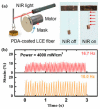A Light-Powered Liquid Crystal Elastomer Spring Oscillator with Self-Shading Coatings
- PMID: 35458275
- PMCID: PMC9028186
- DOI: 10.3390/polym14081525
A Light-Powered Liquid Crystal Elastomer Spring Oscillator with Self-Shading Coatings
Abstract
The self-oscillating systems based on stimuli-responsive materials, without complex controllers and additional batteries, have great application prospects in the fields of intelligent machines, soft robotics, and light-powered motors. Recently, the periodic oscillation of an LCE fiber with a mass block under periodic illumination was reported. This system requires periodic illumination, which limits the application of self-sustained systems. In this paper, we creatively proposed a light-powered liquid crystal elastomer (LCE) spring oscillator with self-shading coatings, which can self-oscillate continuously under steady illumination. On the basis of the well-established dynamic LCE model, the governing equation of the LCE spring oscillator is formulated, and the self-excited oscillation is studied theoretically. The numerical calculations show that the LCE spring oscillator has two motion modes, static mode and oscillation mode, and the self-oscillation arises from the coupling between the light-driven deformation and its movement. Furthermore, the contraction coefficient, damping coefficient, painting stretch, light intensity, spring constant, and gravitational acceleration all affect the self-excited oscillation of the spring oscillator, and each parameter is a critical value for triggering self-excited oscillation. This work will provide effective help in designing new optically responsive structures for engineering applications.
Keywords: light-powered mechanisms; limit cycles; liquid crystal elastomer; self-shading effect; spring oscillator.
Conflict of interest statement
The authors declare that they have no known competing financial interests or personal relationships that could have appeared to influence the work reported in this paper.
Figures













Similar articles
-
Liquid crystal elastomer self-oscillator with embedded light source.Phys Rev E. 2023 Nov;108(5-1):054702. doi: 10.1103/PhysRevE.108.054702. Phys Rev E. 2023. PMID: 38115449
-
Self-Oscillating Liquid Crystal Elastomer Helical Spring Oscillator with Combined Tension and Torsion.Polymers (Basel). 2023 Aug 3;15(15):3294. doi: 10.3390/polym15153294. Polymers (Basel). 2023. PMID: 37571189 Free PMC article.
-
Self-Sustained Collective Motion of Two Joint Liquid Crystal Elastomer Spring Oscillator Powered by Steady Illumination.Micromachines (Basel). 2022 Feb 8;13(2):271. doi: 10.3390/mi13020271. Micromachines (Basel). 2022. PMID: 35208395 Free PMC article.
-
From Light-Powered Motors, to Micro-Grippers, to Crawling Caterpillars, Snails and Beyond-Light-Responsive Oriented Polymers in Action.Materials (Basel). 2022 Nov 18;15(22):8214. doi: 10.3390/ma15228214. Materials (Basel). 2022. PMID: 36431699 Free PMC article. Review.
-
Shape memory materials for electrically-powered soft machines.J Mater Chem B. 2020 Jun 7;8(21):4539-4551. doi: 10.1039/d0tb00392a. Epub 2020 May 6. J Mater Chem B. 2020. PMID: 32373836 Review.
Cited by
-
Thermally Driven Continuous Rolling of a Thick-Walled Cylindrical Rod.Micromachines (Basel). 2022 Nov 21;13(11):2035. doi: 10.3390/mi13112035. Micromachines (Basel). 2022. PMID: 36422464 Free PMC article.
-
Dynamical Behaviors of a Translating Liquid Crystal Elastomer Fiber in a Linear Temperature Field.Polymers (Basel). 2022 Aug 4;14(15):3185. doi: 10.3390/polym14153185. Polymers (Basel). 2022. PMID: 35956704 Free PMC article.
-
Self-Jumping of a Liquid Crystal Elastomer Balloon under Steady Illumination.Polymers (Basel). 2022 Jul 6;14(14):2770. doi: 10.3390/polym14142770. Polymers (Basel). 2022. PMID: 35890544 Free PMC article.
-
Self-sustained chaotic floating of a liquid crystal elastomer balloon under steady illumination.Heliyon. 2023 Mar 10;9(3):e14447. doi: 10.1016/j.heliyon.2023.e14447. eCollection 2023 Mar. Heliyon. 2023. PMID: 36967936 Free PMC article.
-
Photothermal Thin Films with Highly Efficient NIR Conversion for Miniaturized Liquid-Crystal Elastomer Actuators.Polymers (Basel). 2022 Jul 24;14(15):2997. doi: 10.3390/polym14152997. Polymers (Basel). 2022. PMID: 35893961 Free PMC article.
References
-
- Ding W.J. Self-Excited Vibration. Tsing-Hua University Press; Beijing, China: 2009.
-
- Li M.H., Keller P., Li B., Wang X., Brunet M. Light-driven side-on nematic elastomer actuators. Adv. Mater. 2003;15:569–572. doi: 10.1002/adma.200304552. - DOI
-
- Nocentini S., Parmeggiani C., Martella D., Wiersma D.S. Optically driven soft micro robotics. Adv. Opt. Mater. 2018;6:1800207. doi: 10.1002/adom.201800207. - DOI
Grants and funding
- 12172001/National Natural Science Foundation of China
- KJ2020A0453/University Natural Science Research Project of Anhui Province
- gxfx2017053/Outstanding Talents Cultivation Project of Universities in Anhui
- gxyqZD2019056/Outstanding Talents Cultivation Project of Universities in Anhui
- YJS20210499/Postgraduate Research Project of Universities in Anhui Province
LinkOut - more resources
Full Text Sources

